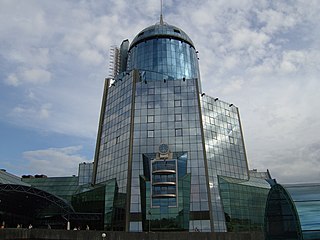
Samara, known from 1935 to 1991 as Kuybyshev, is the largest city and administrative centre of Samara Oblast in Russia. The city is located at the confluence of the Volga and the Samara rivers, with a population of over 1.14 million residents, up to 1.22 million residents in the urban agglomeration, not including Novokuybyshevsk, which is not conurbated. The city covers an area of 541.382 square kilometers (209.029 sq mi), and is the eighth-largest city in Russia and tenth agglomeration, the third-most populous city on the Volga, as well as the Volga Federal District.
Krylya Sovetov was a sports society in the Soviet Union affiliated with aviation/aerospace industry. Today, it may refer to:

Samara Metro, formerly known as the Kuybyshev Metro, is a rapid transit system which serves the city of Samara, Russia. Opened in 1987, it consists of one line with ten stations and approximately 12.7 kilometres (7.9 mi) of bi-directional track.
Sovetsky (masculine), Sovetskaya (feminine), Sovetskoye (neuter), or Sovetskiye (plural) is something named after the Soviet Union.
Samarsky (masculine), Samarskaya (feminine), or Samarskoye (neuter) may refer to:
Teatralnaya metro station may refer to:
Rossiysky (masculine), Rossiyskaya (feminine), or Rossiyskoye (neuter), all meaning Russian, may refer to:
Moskovskaya metro station may refer to:
Sportivnaya is the name of several Russian metro stations:
Gagarinskaya metro station may refer to:
Kirovskaya metro station may refer to:

Stalin's bunker is an air raid shelter located near Samara State University of Culture in Samara, Russia. It is a subterranean bunker complex constructed between February and October 1942. It was the alternative Supreme High Command General Headquarters of the Soviet Armed Forces intended for Joseph Stalin during World War II. Stalin's Bunker is located 37 metres (121 ft) beneath the Kuybyshev CPSU oblast Committee building, 100 metres (110 yd) south-east of the Samara Academy Theater. Stalin's Bunker was declassified in 1990. Now the civil defence museum occupies the former air raid shelter. The air-raid shelters for the Soviet High Command were built also in Yaroslavl, Gorky, Kazan, Ulyanovsk, Saratov and Stalingrad.

Matvey Genrikhovich Manizer was a prominent Russian sculptor. Manizer created a number of works that became classics of socialist realism.

Bezymyanka is a station on the First Line of the Samara Metro. It opened on 26 December 1987 as one of the four initial stations on the line. It is in the Sovetsky district of Samara at the intersection of Ulitsa Pobedy and Novo-Vokzalnaya Ulitsa. Its name comes from a railway station located 700 m southeast and literally means "unnamed".

Kirovskaya is a station on the First Line of the Samara Metro. It opened on 26 December 1987. It is in the Sovetsky district of Samara. The station's name comes from the street on which the station is situated, Prospekt Kirova, which is named for Bolshevik leader Sergey Kirov.

Yungorodok is a station on the Samara Metro. It opened on 26 December 1987 and was intended to be a temporary station until the completion of Krylya Sovetov. When the government changed the plan for the Metro, Krylya Sovetov was abandoned and Yungorodok became a permanent station. It is the southern terminus of the line and the only aboveground station on the system. The name refers to the housing development Yungorodok, a section of Samara which means “young city” in Russian.

Samara-Passazhirskaya is a major railway station of the Kuybyshev Railway in Samara, Russia.








